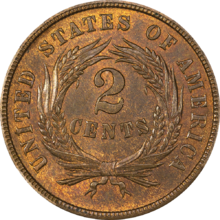Two-cent piece (United States)
| United States | |
| Value | 2 cents (0.02 US dollars) |
|---|---|
| Mass | 6.22 g |
| Diameter | 23.00 mm |
| Edge | plain |
| Composition |
|
| Years of minting | 1864–1873 |
| Mint marks | None, all struck at Philadelphia Mint |
| Obverse | |
 |
|
| Design | Shield, IN GOD WE TRUST on banner, date below. |
| Designer | James Barton Longacre |
| Design date | 1864 |
| Reverse | |
 |
|
| Design | Wheat wreath, UNITED STATES OF AMERICA legend, 2 CENTS in center. |
| Designer | James Barton Longacre |
| Design date | 1864 |
The two-cent piece was produced by the Mint of the United States for circulation from 1864 to 1872 and for collectors in 1873. Designed by James B. Longacre, there were decreasing mintages each year, as other minor coins such as the nickel proved more popular. It was abolished by the Mint Act of 1873.
The economic turmoil of the American Civil War caused government-issued coins, even the non-silver Indian Head cent, to vanish from circulation, hoarded by the public. One means of filling this gap was private token issues, often made of bronze. The cent at that time was struck of a copper-nickel alloy, the same diameter as the later Lincoln cent, but somewhat thicker. The piece was difficult for the Philadelphia Mint to strike, and Mint officials, as well as the annual Assay Commission, recommended the coin's replacement. Despite opposition from those wishing to keep the metal nickel in the coinage, led by Pennsylvania Congressman Thaddeus Stevens, Congress passed the Coinage Act of 1864, authorizing bronze cents and two-cent pieces.
Although initially popular in the absence of other federal coinage, the two-cent piece's place in circulation was usurped by other non-precious metal coins which Congress subsequently authorized, the three-cent piece and the nickel. It was abolished in 1873; large quantities were redeemed by the government and melted. Nevertheless, two-cent pieces remain inexpensive by the standards of 19th-century American coinage.
A two-cent piece had been proposed in 1806 by Connecticut Senator Uriah Tracy, along with a twenty-cent piece or "double dime". Reflecting the then-prevalent view that coins should contain their value in metal, Tracy's bill provided that the two-cent piece be made of billon, or debased silver. The bill was opposed by Mint Director Robert Patterson, as it would be difficult to refine the silver from melted-down pieces. Although Tracy's legislation passed the Senate twice, in 1806 and 1807, it failed in the House of Representatives. Patterson sent a brass button with two of the billon planchets that would have been used for the coin to Tracy, showing how hard it would be to prevent counterfeiting. The Mint considered a two-cent piece in 1836, and experiments were conducted by Second Engraver Christian Gobrecht and Melter and Refiner Franklin Peale. The piece was to be again of billon, and provision for the coin was included in early drafts of the Mint Act of 1837, but the proposal was dropped when Peale was able to show that the coin could be easily counterfeited.
...
Wikipedia
